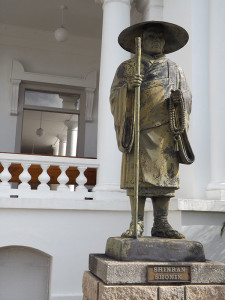 We will observe Gotan-e at the Hawaii Betsuin with the Gotan-e Otaiya on Saturday, May 20, 2017 at 7:00 pm and on Sunday, May 21st with a combined service at 9:30 am. The guest speaker will be Rev. Kevin Kuniyuki, director of the Buddhist Study Center (see bio below). Please join us in commemorating the birth, life and accomplishment of our founder, Shinran Shonin.
We will observe Gotan-e at the Hawaii Betsuin with the Gotan-e Otaiya on Saturday, May 20, 2017 at 7:00 pm and on Sunday, May 21st with a combined service at 9:30 am. The guest speaker will be Rev. Kevin Kuniyuki, director of the Buddhist Study Center (see bio below). Please join us in commemorating the birth, life and accomplishment of our founder, Shinran Shonin.
The birthday of the founder of Jodo Shinshu Buddhism, Shinran Shonin, is commemorated during the month of May in all Jodo Shinshu temples in Japan and worldwide, including Hawaii and the US mainland. Known as Gotan-e, this is one of the six major services observed annually by Jodo Shinshu temples to honor and pay respect to Shinran Shonin.
Shinran Shonin lived during the age of Mappo and diligently practiced the asceticism of the Tendai tradition for twenty years on Mt. Hiei. However, he finally came to the realization that such rigorous practices did not lead to his awakening and liberation. Shinran Shonin was troubled by his own blind passions or “bonno” and, despite twenty years of ascetic practices, he could not attain the enlightenment he was seeking.
After undergoing a hundred-day retreat at Rokkaku-do temple in Kyoto, the Bodhisattva Kannon appeared to him in a dream in the form of Prince Shotoku directing him to see Honen Shonin. Shinran descended from Mt. Hiei and became a disciple of Honen. During the first year of his discipleship with Honen Shonin, Shinran, at age 29, attained enlightenment or salvation through the Vow of Amida Buddha, the Buddha of Infinite Light and Life. This attainment of salvation through relying solely on the power of Amida’s vow and discarding all sundry practices became the core of Shinran’s teachings throughout his life.
Essentially Shinran said that because we are all defiled by greed, hatred and delusion, we have no chance of gaining enlightenment by ourselves and that by entrusting ourselves totally to Amida Buddha without any calculation or doubt, we are assured of birth in the Pure Land. Shinran stressed absolute reliance on the other power of Amida’s vow. One’s own efforts are useless in achieving salvation. Even faith in the Nembutsu arises, not through the individual’s own efforts or virtue, but is bestowed by Amida’s grace.
By sharing, teaching and being an example for many ordinary common people, Shinran’s experience of spiritual awakening through the workings of Amida Buddha’s Vow spread the Nembutsu teachings that made the Buddhism of his time available to all classes of people, not just for religious orders and the ruling class of Japanese society.
During the time of his active ministry in the Kanto area of Japan and thereafter, Shinran Shonin continued spreading the Nembutsu teaching, even in his later years, until he passed away in Kyoto in 1263. The temple of the original vow, the Hongwanji, was established years later Shinran’s Birthday service continued from page 1 after Shinran’s death and has since grown to become the largest sect of Japanese Buddhism in Japan and other parts of the world.
In honor, recognition, and respect, we celebrate Shinran Shonin’s birthday this month of May and reflect with gratitude his sharing and spreading the Nembutsu teaching which has ever since affected countless numbers of people and has survived on to our present age. Happy Birthday Shinran sama.
Namo Amida Butsu
Guest Speaker: Rev. Kevin Kuniyuki

Rev. Kevin Kuniyuki


